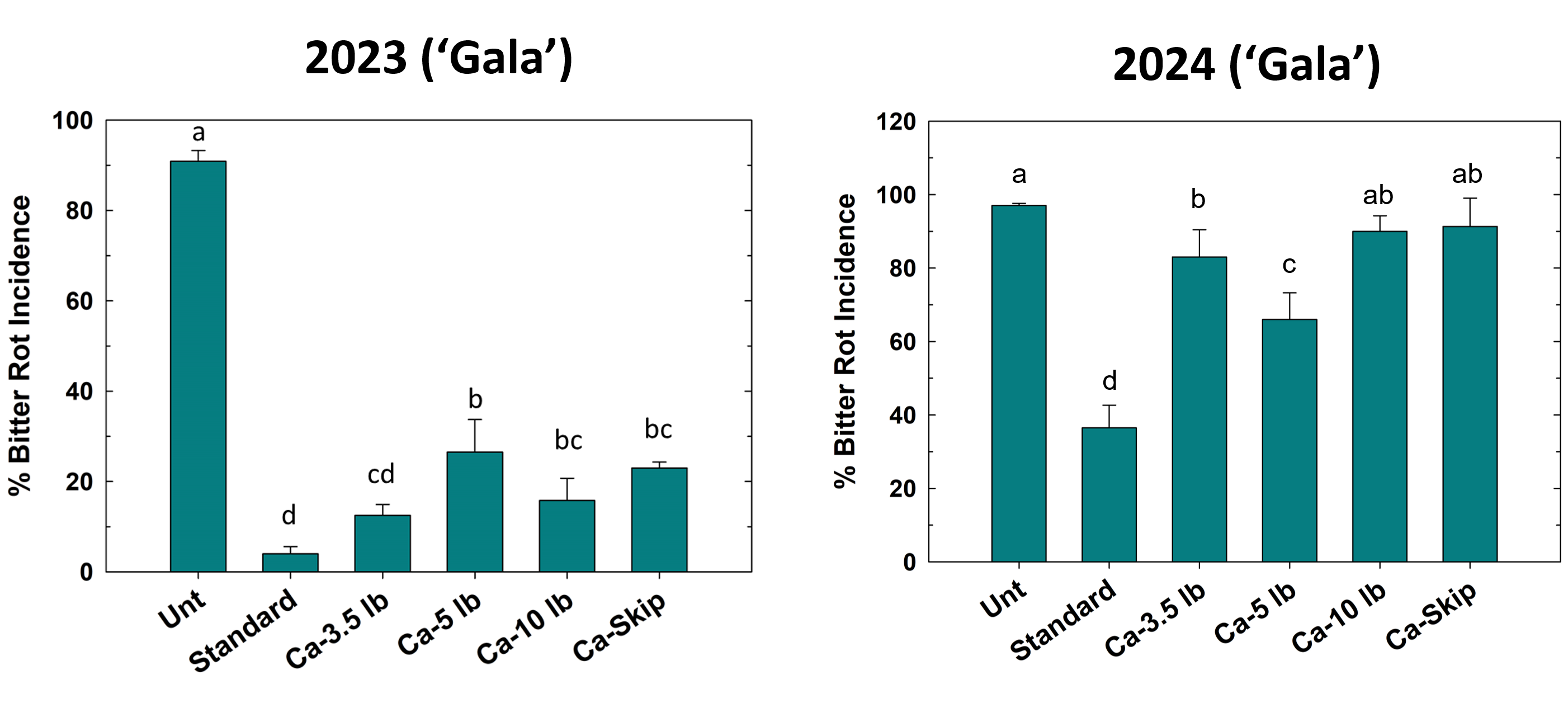Apple Disease Update: Week of May 11, 2025
go.ncsu.edu/readext?1072022
en Español / em Português
El inglés es el idioma de control de esta página. En la medida en que haya algún conflicto entre la traducción al inglés y la traducción, el inglés prevalece.
Al hacer clic en el enlace de traducción se activa un servicio de traducción gratuito para convertir la página al español. Al igual que con cualquier traducción por Internet, la conversión no es sensible al contexto y puede que no traduzca el texto en su significado original. NC State Extension no garantiza la exactitud del texto traducido. Por favor, tenga en cuenta que algunas aplicaciones y/o servicios pueden no funcionar como se espera cuando se traducen.
Português
Inglês é o idioma de controle desta página. Na medida que haja algum conflito entre o texto original em Inglês e a tradução, o Inglês prevalece.
Ao clicar no link de tradução, um serviço gratuito de tradução será ativado para converter a página para o Português. Como em qualquer tradução pela internet, a conversão não é sensivel ao contexto e pode não ocorrer a tradução para o significado orginal. O serviço de Extensão da Carolina do Norte (NC State Extension) não garante a exatidão do texto traduzido. Por favor, observe que algumas funções ou serviços podem não funcionar como esperado após a tradução.
English
English is the controlling language of this page. To the extent there is any conflict between the English text and the translation, English controls.
Clicking on the translation link activates a free translation service to convert the page to Spanish. As with any Internet translation, the conversion is not context-sensitive and may not translate the text to its original meaning. NC State Extension does not guarantee the accuracy of the translated text. Please note that some applications and/or services may not function as expected when translated.
Collapse ▲ After my optimistic forecast for last week was very incorrect, I’m hesitant to make any further comments on the weather this week. Several of you likely applied a fungicide on Friday, after the hail storm and if that’s the case, you likely won’t be making another application until this Friday at the earliest. At the end of this post I’ll provide some thoughts on fungicide selection, but first I promised last week to show some of our recent research with calcium for bitter rot and GLS control.
After my optimistic forecast for last week was very incorrect, I’m hesitant to make any further comments on the weather this week. Several of you likely applied a fungicide on Friday, after the hail storm and if that’s the case, you likely won’t be making another application until this Friday at the earliest. At the end of this post I’ll provide some thoughts on fungicide selection, but first I promised last week to show some of our recent research with calcium for bitter rot and GLS control.
In 1999, Dr. Alan Biggs, (now) retired tree fruit pathologist at the WVU Kearneysville Tree Fruit Research and Education Center, did a series of experiments with different calcium formulations for the control of apple bitter rot. In these experiments the following were observed:
- When fungal spore load was low, calcium chloride suppressed bitter rot on ‘Nittany’ and ‘Golden Delicious’ fruit.
- Approximately 2.5 lb DowFlake Extra (~3 lb CaCl)/A sprayed dilute significantly reduced the incidence of bitter rot on ‘Golden Delicious’ and ‘Nittany’ in inoculated field trials inoculated with Colletotrichum species causing bitter rot on apple
- No reduction in Colletotrichum spp. conidia (spore) germination was observed, but calcium chloride (CaCl2) did suppress growth of the bitter rot fungus after germination occurred.
Based on these results from WVU and observations from western NC apple growers that higher rates of CaCl2 reduced the incidence of bitter rot in ‘Honeycrisp’ apples, we decided to look at varying rates of calcium chloride for controlling Colletotrichum chrysophilum and Colletrichum fioriniae, the predominant species causing Glomerella and bitter rot in NC, respectively.
In the lab, our first goal was to determine if calcium chloride (CaCl2) was directly toxic to the two Colletotrichum species. We put differing rates of CaCl2 into agar and then spread spores of the fungi onto the hardened agar in Petri dishes. The most sensitive isolates had 50% of spore germination prohibited when the CaCl2 concentration was 40,000 ppm. If I did my calculations correctly, the normal 2 lb/100 gal rate you are applying in the field is 2,040 ppm CaCl2. The 10 lb/100 gal rate that some growers have tried is 10,200 ppm CaCl2. The practicality of these results indicate that while CaCl2 can reduce spore germination, the rate would exceed any rate that you’d apply in the field.

Concentration of calcium chloride at which 50% of conidia (spore) germination is inhibited. Red bars are individual isolates of Colletotrichum fioriniae, the fungus that causes bitter rot in NC. Yellow bars are individual isolates of Colletotrichum chrysophilum, the fungus that causes Glomerella in NC.
We then conducted field trials in our ‘Gala’ research block at the MHCREC in Mills River NC to understand if different rates of CaCl2 rotated in a conventional fungicide program would reduce the incidence of bitter rot (Glomerella fruit rot) on apple. Although we didn’t observe direct toxicity on spore/conidial germination in the lab, CaCl2 (applied as DowFlake Xtra) could cause direct toxicity to other fungal growth stages or perhaps enhance the structural integrity of the apple fruit, making infection more difficult. The trials were conducted in 2023 and 2024:
- “Untreated”: No fungicide or DowFlake applied
- “Standard”: 2.5 lb/A Captan 80WDG applied weekly; No DowFlake
- 2.5 lb/A Captan 80WDG + 3.5 lb/100 gal DowFlake alternated with 3.5 lb/100 gal DowFlake weekly
- 2.5 lb/A Captan 80WDG + 5 lb/100 gal DowFlake alternated with 3.5 lb/100 gal DowFlake weekly
- 2.5 lb/A Captan 80WDG + 10 lb/100 gal DowFlake alternated with 3.5 lb/100 gal DowFlake weekly
- “Ca-Skip”: 2.5 lb/A Captan 80WDG applied every 14 days
 Before we even talk about CaCl2, I’d like to point out from the 2024 graph how poorly Captan 80WDG performs when applied every two weeks (remember even with the DowFlake treatments, captan was skipped very other week and just the DowFlake was applied…). Ok now for the DowFlake. In ‘Gala’ apple in 2023, the standard treatment (Captan 80WDG applied weekly), resulted in lower bitter rot incidence compared to all other treatments. In general, the rate of DowFlake had no effect on bitter rot incidence, and did not differ from the treatment in which Captan 80WDG was applied every 14 days (“Ca-Skip”). In 2024, like I said disease pressure was much much higher. The standard weekly Captan applications still resulted in the lowest incidence of bitter rot, BUT the 5 lb/100 gal rate of DowFlake did reduce bitter rot incidence compared to the the other DowFlake rates and the treatment in which Captan 80WDG was applied every 2 weeks (“Ca-Skip”).
Before we even talk about CaCl2, I’d like to point out from the 2024 graph how poorly Captan 80WDG performs when applied every two weeks (remember even with the DowFlake treatments, captan was skipped very other week and just the DowFlake was applied…). Ok now for the DowFlake. In ‘Gala’ apple in 2023, the standard treatment (Captan 80WDG applied weekly), resulted in lower bitter rot incidence compared to all other treatments. In general, the rate of DowFlake had no effect on bitter rot incidence, and did not differ from the treatment in which Captan 80WDG was applied every 14 days (“Ca-Skip”). In 2024, like I said disease pressure was much much higher. The standard weekly Captan applications still resulted in the lowest incidence of bitter rot, BUT the 5 lb/100 gal rate of DowFlake did reduce bitter rot incidence compared to the the other DowFlake rates and the treatment in which Captan 80WDG was applied every 2 weeks (“Ca-Skip”).
What do these results mean? Well, first let me implore you to continue to apply calcium to your fruit starting around this time of year. Even if the results in our GLS ‘Gala’ research orchard were underwhelming, from a fruit quality perspective calcium is important. Second, I’d like to repeat these trials in ‘Honeycrisp’ which is much more prone to calcium disorders compared to ‘Gala’ . ‘Honeycrisp’ is a magnet for bitter rot and I’d be curious as to the indirect impacts higher calcium concentrations may have. Lastly, once we get our microscope camera and software we will be evaluating how calcium impacts other growth stages of the Colletotrichum species causing disease in apple in NC.
Ok, now fungicides to apply this week:
- I’m a fan of attacking early inoculum of Glomerella and bitter rot. If you don’t have or don’t suspect resistance to the strobilurins (FRAC 11), AND you have sprayed one or zero applications of Merivon this season, I’d go with 3 lb/A Manzate (if you haven’t applied 7 applications already this season and you’re within the 77 day PHI) PLUS Merivon (5.5 fl oz/A). If you are at your max applications of Manzate for the season or within the 77 day PHI, swap it with 2.5 lb/A Captan 80WDG.
- If you applied Merivon last week, go with Manzate 3 lb/A OR Captan 80WDG 2.5 lb/A
- If you suspect or know you have resistance to the strobilurins, consider Aprovia 7 fl oz/A PLUS Manzate 3 lb/A OR Captan 80WDG 2.5 lb/A. See my first bullet point for mancozeb vs captan considerations.
- For managing Alternaria leaf spot in ‘Red Delicious’ apply 2.5 lb/A Captan 80WDG instead of mancozeb. If you’ve only applied one application so far of a strobilurin fungicide in this cultivar for the season, add one to the tank mix (e.g. Flint Extra, Luna Sensation, Merivon, Pristine).


